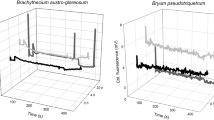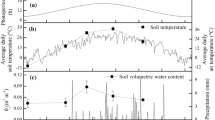Abstract
Tortula ruralis is a homoiochlorophyllous-desiccation-tolerant (HDT) moss that retains all pigments when dehydrated and rapidly recovers physiological function upon rehydration. This moss forms extensive cover in exposed and shaded areas in the sandy semi-arid grasslands of Central Europe. We hypothesized that contrasting drying regimes between these microhabitats would affect plant N status, constraints to gas exchange and growth, as well as result in altered pigment concentrations and ratios, and photochemical light-response dynamics. Furthermore, we believed T. ruralis's HDT habit would limit its ability to acclimate to altered light environment. We found that sun plant T. ruralis had lower plant mass, as well as lower tissue N, C, total photosynthetic pigment concentrations and carbon isotope discrimination (Δ) values compared to shade plant counterparts. Carotenoid/chlorophyll ratios in sun plants were typical of high light-adapted tissue, but chlorophyll a/chlorophyll b ratios were lower, more characteristic of low light-adapted tissue. This unique combination of pigment responses was accompanied by sustained lower levels of optimal quantum efficiency of PSII (F v/F m) in sun plant T. ruralis, even during favorable diurnal conditions, and reduced engagement of energy-dependent thermal dissipation (NPQ). Reciprocal transplants of sun and shade plants showed that T. ruralis is capable of short-term adjustment to altered light level, as evidenced by increases in F v/F m, NPQ, and light-adapted PSII yield (φPSII) in transplanted sun plants, and concurrent decreases in sun-transplanted shade plants. However, the performance of transplanted sun plants remained consistently below that of undisturbed shade plants. These findings show that microenvironmental variation results in different patterns of resource acquisition in this HDT moss, and that growth in the open imparts greater desiccation tolerance, and the development of a greater standing engagement of slowly reversing photoprotective mechanisms. In contrast, prolonged activity and greater resource acquisition in shaded populations may allow T. ruralis to rapidly adjust to changes following disturbance to the plant canopy, fostering the persistence of T. ruralis in these semi-arid grasslands.
Similar content being viewed by others
Author information
Authors and Affiliations
Corresponding author
Additional information
Electronic Publication
Rights and permissions
About this article
Cite this article
Hamerlynck, E.P., Csintalan, Z., Nagy, Z. et al. Ecophysiological consequences of contrasting microenvironments on the desiccation tolerant moss Tortula ruralis. Oecologia 131, 498–505 (2002). https://doi.org/10.1007/s00442-002-0925-5
Received:
Accepted:
Published:
Issue Date:
DOI: https://doi.org/10.1007/s00442-002-0925-5




